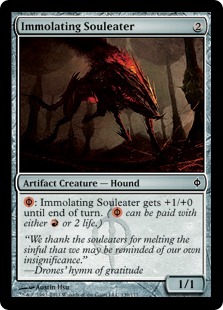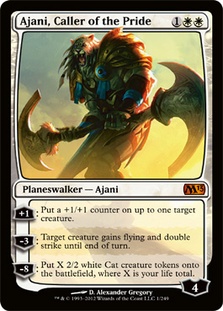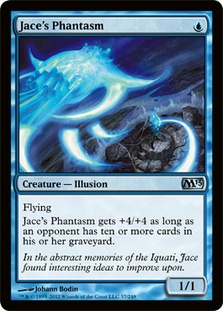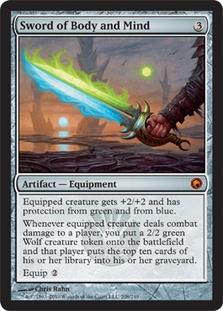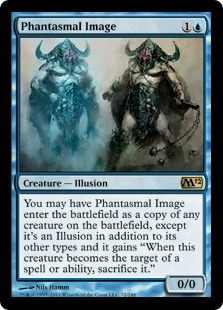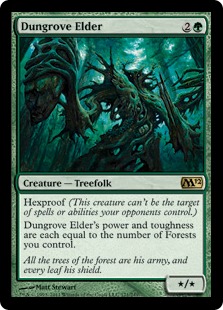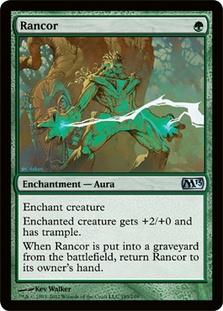It’s that time. The time where everyone and their dog is all about M13.
It doesn’t take Kai Budde to tell you Thundermaw Hellkite is good. I’m delving a little bit deeper and looking where the new cards might intersect with an oldie or two.
Here we go!
Immolating Souleater + Ajani, Caller of the Pride
How it works: Pretty simply. Play Immolating Souleater on turn 2. On turn 3, Ajani gives it double strike and flying, then pay eighteen life for +9/+0 and attack for 20.
This is, by far, the most dangerous combo in the set. Note that doesn’t necessarily mean it’s good. "Dangerous" is used here in the sense of sheer game-ending power, like Yawgmoth’s Will or Past in Flames. Sakura-Tribe Elder and Force of Will are both very good cards, but they aren’t scary ones. That title is reserved for cards like Primeval Titan. You can imagine a blinking red light that goes off in your field of vision when you see these cards on the other side of the table, and a recorded voice saying, "Warning! If you do not answer this card in the next turn, please evacuate the game immediately."
To put it into perspective, I don’t believe a legitimate turn 3 kill in Standard has existed since the days of Urza’s Saga. Affinity could technically pull it off, as could Goblin Guide decks, but you needed an extremely unlikely draw. The existence of Souleater + Ajani fundamentally changes the way the game is played. Imagine you’re on the play and your opponent has a turn 2 Souleater. You untap, draw, and play your third land with Blade Splicer and Vapor Snag in hand; what do you do? He’s only 45%ish to have Ajani on turn 3, but that represents the odds you lose the game on the spot if you tap out. You have to effectively Time Walk yourself and pass the turn for minimal gain.
It’s a lot like Dark Ritual / Hatred. But perhaps there aren’t too many people reading this article who remember those days, so we’ll go with a more recent example. It’s a little like Deceiver Exarch + Splinter Twin. I won more than my fair share of games with that deck by opponents being forced into making terrible decisions even when I didn’t have the combo in hand. Perhaps I can’t answer a Hero of Bladehold and I can’t punish them for tapping out for it, but they don’t know that! From their perspective, that might be the play that costs them the game. So they leave Mana Leak up and pass, sometimes against my hand of land and three Splinter Twins.
The other advantage of Souleater + Ajani is that neither is useless on its own. Far from it. Ajani is very good as a piece of any ordinary aggressive draw; think Loyal Cathar or Mirran Crusader. Immolating Souleater is a lot worse, but he’s still a body, which is more than a superfluous Splinter Twin could claim. More than that—he’s a body that makes them play badly. He makes them cast an awkward Bonfire of the Damned for one instead of the normal Borderland Ranger.
But there is a drawback, and it’s a big one. Namely: you must be at the same or more life than the opponent to go off. If they hit you for two with a Strangleroot Geist before you drop Ajani, suddenly your Dark Ritual / Hatred does nothing. A few red mana can alter the math slightly, but you can’t get yourself out of a hole. If they flip a turn 1 Delver or curve Llanowar Elves into Strangleroot + Rancor, you can draw all the Ajanis and Souleaters you like—they’ll never be relevant.
This takes away the most appealing aspect of the two-card combo, namely that you can ignore whatever it is they’re doing as long as it doesn’t directly interact with your stuff. Exarch/Twin beat up on aggressive decks all day long by simply being a turn faster than them. Ajani/Souleater doesn’t have that luxury. As soon as it gets hit, it’s reeling. There’s no simple "point, click" to turn a losing game into a win.
There’s also the somewhat prosaic fact that they can kill or counter your stuff. This affects all combos, but Souleater + Ajani more so than most. Immolating Souleater is particularly fragile. All it takes is Dismember or Vapor Snag to turn "combo kill you" into "take eighteen, die." In some circumstances you can play around either card, but you can’t play around everything all the time. This combo won’t take off as long as Gut Shot is a significant part of the metagame.Â
So, is the deck playable? I think so, with the caveat that there isn’t an Ajani/Souleater "deck." Souleater can be incorporated into aggressive white strategies that would want to play Ajani anyway. As noted previously, it’s an ok card on its own that must always be respected and gives you a bunch of free wins. It’s worth noting that you get Silverblade Paladin for free as a redundant combo piece. Combining it with Souleater gives you the turn 3 kill if they have a slow start or mows down a Delver of Secrets or Flinthoof Boar.
Perhaps something like:
Creatures (25)
- 4 Immolating Souleater
- 2 Fiend Hunter
- 4 Champion of the Parish
- 4 Doomed Traveler
- 3 Mayor of Avabruck
- 4 Loyal Cathar
- 4 Silverblade Paladin
Planeswalkers (4)
Lands (23)
Spells (8)

The addition of Souleater and Ajani changes the emphasis from "put a lot of creatures in play" to "win with a single, unstoppable threat," and hence the addition of green and Rancor to an otherwise stock Humans list. Rancor with double strike is way too powerful, and between Ajani and Silverblade Paladin you’ll have it more often than not.
While you want eight one-drops, I don’t really like the Doomed Travelers in this list because without Moorland Haunt and Honor of the Pure they lose a lot of value. It’s possible they could become Avacyn’s Pilgrim and the mana base be reworked. Maybe this:
Creatures (24)
- 4 Immolating Souleater
- 2 Fiend Hunter
- 4 Champion of the Parish
- 4 Avacyn's Pilgrim
- 3 Deranged Outcast
- 3 Restoration Angel
- 4 Silverblade Paladin
Planeswalkers (5)
Lands (23)
Spells (8)

Word to the wise on decklists: these are really just starting points. If you see them and think, "Why hasn’t he included this or that card, and what’s that other card doing in there?" well, you might just be right! Modify, test, and modify further as you see fit. I make no claim to breaking the format or even producing playable decks. These are but germs of ideas that can be seeded and watered, the weeds removed, and the beatdown fruit harvested.
Jace’s Phantasm + Sword of Body and Mind
How it works: Milling them for ten with nothing but Thought Scours is tough. Doing the same thing with the Sword everyone forgot is easy.
So Jace’s Phantasm. I don’t want to be that guy who rains on everyone’s parade, but I don’t see him. He’s been compared to Delver of Secrets, but Flying Men is more apt.
Jace’s Phantasm has the "Exotic Orchard problem." Reflecting Pool is a great card, but Exotic Orchard isn’t; why is that? The issue here is that you can’t control what your opponent does. They might be playing the exact same colors as you, making Exotic Orchard a painless City of Brass (that’s what a few Jund pilots gambled on in the days when it was a solid 40-50% of the metagame.) They might also be playing White Weenie, making Exotic Orchard a Wizard’s School minus the upside. That’s not good enough. You need to know that all the cards in your deck are going to do exactly what you planned them to.
Similarly, you have very little control over how many cards go into your opponent’s graveyard. If they’re playing Esper Control or Frites, great. If they’re playing Naya Pod or G/R Aggro, awwww. Nimble Mongoose to Phantasm is roughly Reflecting Pool to Exotic Orchard. Just as you can play Vivid Creek to turn on your own Reflecting Pool, you can play Forbidden Alchemy, cheap cantrips, Faithless Looting, whatever to turn on your own Nimble Mongoose. Sure, your opponent might be playing Vivid Creek and Forbidden Alchemy, but then he might be playing Plains and Student of Warfare instead.
So why mention him at all? Well, his stats are great, but sitting around hoping they end up with ten cards in their bin one way or the other is a loser’s game. You have to be proactive in leveling him up, and there’s no better way to do this than with the oft-maligned Sword of Body and Mind. People tend to forget, but this card was widely played before the release of Sword of War and Peace + Batterskull. Making a Wolf is perhaps the best ability on any of the Swords; it’s the fact that the blue ability is blank and often outright harmful that’s prevented it from seeing play.
Creatures (18)
Lands (20)
Spells (22)

A highly optimistic Delver list. It’s unclear if the interaction will be good enough to fit into the streamlined Delver builds of today. Access to quasi-Delvers five through eight is nice, though, and could be worth the slight Sword downgrade.
A possible different direction is to go big: add Jace, Memory Adept in conjunction with Visions from Beyond. Penciling out some possible decklists doesn’t fill me with optimism about this idea, but it’s out there if you’re a bolder visionary than I.
Serra Avenger + Phantasmal Image
How it works: Play both on turn 4. At worst, you have a pair of 3/3 fliers. That’s a hefty beatdown.
Ok, this isn’t a combo in the strictest sense. Just two individually good cards that work well together. Playing Serra Avenger on turn 4 is great, but you want something to do with the extra mana otherwise it might as well be Phantom Monster.
This has been a tricky problem since the Angel first came into existence in Time Spiral. There, she was mostly played in G/W Midrange or R/W/U Angels. Luckily for WW Angels all around, there were no colorless lands anyone wanted to play. Just casting two Avengers on turn 4 was legitimate, or Serra Avenger + Watchwolf, Selesnya Guildmage, or Lightning Helix. There was also a particularly nice synergy with Garruk Wildspeaker. These days it’s a little trickier to take advantage of the Angel discount. And there’s another problem: if you have a two-drop in hand to deploy with the Avenger, why didn’t you just play it turn 2?
Serra Avenger fits best into a deck with cheap spells it doesn’t necessarily want to cast early. In today’s Standard format that means: a blue deck. Snapcaster Mage, Mana Leak, and Phantasmal Image are a formidable array of two-drops to face on turn 4 or beyond. Phantasmal Image especially so—"two-drop that’s a great play later in the game" is practically his middle name.
The most logical place for all of these cards has to be U/W Midrange. Luckily, we already have a blueprint for how that deck should look pre-M13 in the Delverless Delver deck making waves on Magic Online. An update could be:
Creatures (19)
- 3 Serra Avenger
- 4 Blade Splicer
- 2 Phantasmal Image
- 4 Snapcaster Mage
- 4 Restoration Angel
- 2 Talrand, Sky Summoner
Lands (23)
Spells (18)

I like that Serra Avenger gives this deck more "oomph." Previously, removal like Vapor Snag could be awkward because without Delvers you couldn’t take advantage of the tempo swing. Now you can run a more resilient three-power flier that shrugs off Gut Shot, Mortarpod, and the like.
Dungrove Elder + Rancor
Stupid green beats?
Yes please!
Dumb green creatures haven’t been this good since the days of Jamie Wakefield. Day of Judgment? Cool, I guess I lose half my Strangleroot Geist and keep Predator Ooze. Vapor Snag? Can’t touch a Dungrove Elder, and a Rancored Geist will be right back to bother you next turn.
Green Sun’s Zenith, Strangleroot Geist, Rancor, and Dungrove Elder are some of the best midrange green cards since Fires of Yavimaya and Blastoderm (which wouldn’t even be that good these days). They’re complemented by plenty of one-drop mana accelerators and a choice of haymakers. I admit a soft spot for Predator Ooze, but he seems genuinely good in a deck that can consistently cast him turn 2 and often Rancor him up.
This is where I would start:
Creatures (22)
- 4 Llanowar Elves
- 4 Arbor Elf
- 1 Thrun, the Last Troll
- 4 Dungrove Elder
- 4 Strangleroot Geist
- 3 Predator Ooze
- 1 Wolfir Silverheart
- 1 Thragtusk
Planeswalkers (2)
Lands (24)
- 24 Forest
Spells (12)

Nothing fancy, just face-smashy. Expect Stompy to be a real deck in the coming months, probably within 5-10 cards of this list. Building (or playing) the best green aggro deck isn’t rocket surgery. The sideboard is trickier, and sadly being a mono-green list limits your options here. Traditionally control decks get a lot better against you than you do against them, because you only have access to creatures and, well, more creatures. Fortunately Triumph of Ferocity is a card, and Plummet effects are excellent against the various stripes of Delver.
Until next time,
Jeremy

